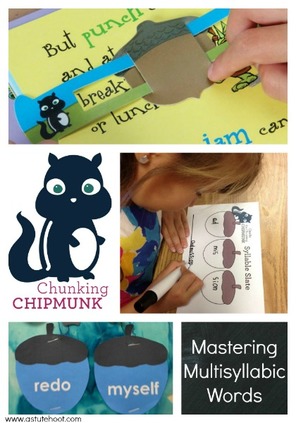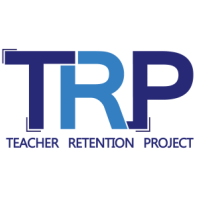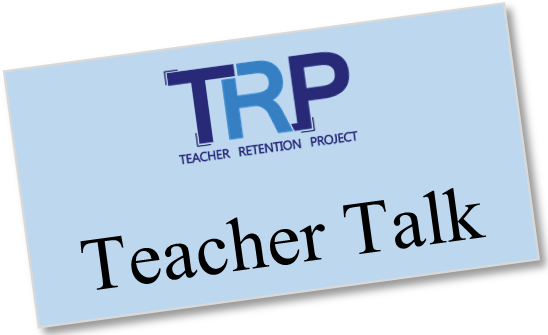
“I’m Charlie the Chunking Chipmunk. What’s new?
I break words into small chunks and you can, too.
Look for little words or sounds that you already know,
Join these sounds together to be the star of the show!”
WHAT is chunking? Chunking means breaking multisyllabic words into small units such as onsets and rimes, phonograms or letter combinations, syllables or morphemes.
WHY is chunking important? As students begin reading multisyllabic words, it is important for them to know how to break words into units larger than individual sounds. Identifying individual syllables is important because it helps students determine the correct vowel sound. By following syllabication rules, students can learn how to properly divide or chunk a word into syllables, which improves decoding and spelling.
HOW do I teach chunking? Explain that Charlie helps readers decode larger, unknown words by breaking the word into smaller chunks. Teach specific syllable types to show students how to chunk words. Decide which syllable types to teach based on your students’ instructional levels.
- Closed syllable: A syllable with one short vowel ending in one or more consonants (e.g., sunset, dishpan, lunchbox)
- Open syllable: A syllable that ends with a long vowel sound, spelled with a single vowel letter (e.g., open, myself, redo)
- Vowel consonant –e: A syllable with a long vowel, spelled with one vowel and one consonant and a silent e (e.g., shipmate, athlete)
- Consonant –le: An unaccented final syllable that contains a consonant before /l/, followed by a silent e (e.g., apple, little)
- Vowel team: A syllable with long or short vowel spellings that use two to four letters to spell the vowel (e.g., toaster, season)
- Vowel –r: A syllable with er, ir, or, ar, or ur in which vowel pronunciation often changes before /r/ (e.g., return, perfect)
We recommend using our Charlie Chunking Chipmunk resources as a supplement to a research-based, multi-sensory phonic program that includes structured, explicit, systematic, cumulative instruction. Although we do not endorse a specific program, our students have demonstrated great success using the Wilson Language System and the Spalding Method. Read reviews of specific literary programs at What Works Clearinghouse.
WHEN should I use chunking?
Explicit reading strategy instruction should be included in a balanced literacy program. Charlie Chunking Chipmunk can be incorporated into various components of literacy lessons. Here are some specific examples of when to use Charlie:
- Phonics Fun: Choose several two- or three-syllable words from a weekly spelling list or phonics word study list. Choose a multi-sensory strategy (see below) to count syllables. Guide students through syllabication of each word on laminated Charlie’s Syllable Slates (see below). First students write each syllable in one of Charlie’s acorns and then write the whole word on the line below. Discuss syllable types and rules as applicable.
- Guided Reading: Introduce or review the chunking strategy by reading the Charlie Chunking Chipmunk Poem. Read aloud your selected guided reading text and model using Charlie’s Syllable Slate to read multisyllabic words in context. Call on individual students to practice using Charlie’s Slate with additional words. Encourage students to use Charlie Chunking Chipmunk’s strategy when they are reading independently as well.
- Chunking Chipmunk Reading Center: Create a portable reading center. Place Charlie’s Syllable Slate or a laminated copy of the Two-Syllable Chunking Chipmunk Reproducible and/or Three-Syllable Chunking Chipmunk Reproducible, dry erase marker, eraser, and 10 to 20 targeted multisyllabic words written on index cards or preprinted on flashcards in a large manila envelope with a copy of the Charlie Chunking Chipmunk Poem glued onto the front. Instruct students that during center time they are to take an envelope to their desks and apply Charlie’s strategy to practice reading the words and then practice spelling by using the dry erase marker to write the words on the laminated reproducible or slate.
About the Authors
Jessica Murphy and Jennifer Zoglman are founders of Astute Hoot: Tools for the Wise Teacher. With a combined total of almost 30 years experience in early childhood and special education classroom teaching, early literacy research, and teacher coaching, they joined forces with Jennifer’s sister, Tina, an award-winning graphic designer, to create a dynamic cast of reading and math strategy animals. The strategy animals made their way into a group of targeted teaching and learning tools that have contributed to the creation of proficient readers and mathematicians in classrooms across the country! Check out their blog: www.astutehoot.com to see how they awaken the joy of learning in all students!


 RSS Feed
RSS Feed